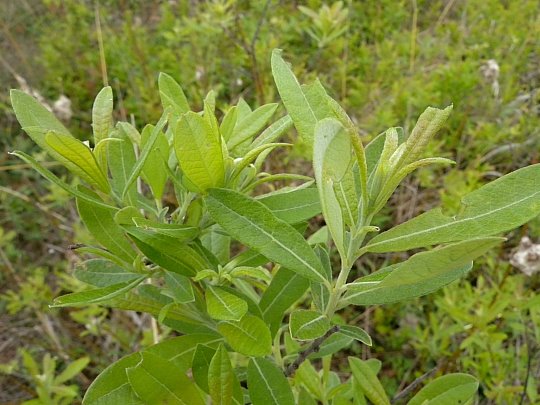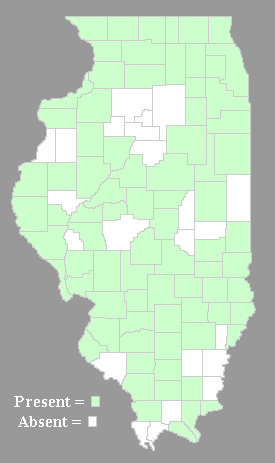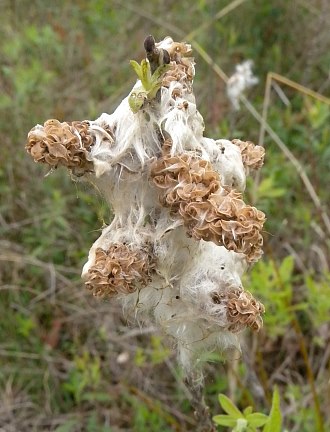
Because Prairie Willow is dioecious, different shrubs will develop either all male (staminate) catkins or all female (pistillate) catkins from the bud scales along twigs of the preceding year. Male catkins are ¼-¾" in length, becoming longer as they mature. They are covered with silvery hairs at first, but later become yellowish or reddish from the anthers of numerous florets. Each male floret consists of a pair of stamens and a hairy bract. Female catkins are ½-3" in length, becoming longer as they mature. Each female catkin has several greenish female florets along its length. A female floret consists of a greenish ovary about 4-8 mm. in length and a hairy bract. The ovary is narrowly lanceoloid in shape with an elongated beak; it is also short-pubescent with a pair of stigmata at its apex. The male and female florets have neither petals nor sepals. The blooming period occurs from early to mid-spring for about 1 week. Afterwards, the female florets develop into seed capsules that become light brown at maturity, when they split open to release tiny seeds that are embedded in cottony hairs. These seeds are dispersed by the wind. The root system is woody and branching. This shrub reproduces by reseeding itself.

Cultivation: The preference is full or partial sun, moist to dry-mesic conditions, and soil that is loamy, gravelly, or sandy. New plants can be started by inserting cut-stems into the ground during the spring, where they will form roots. Prairie Willow is more tolerant of dry conditions than many other species in the genus. It is relatively slow-growing for a willow, usually remaining less than 4' tall, although sometimes Prairie Willow becomes larger when conditions are favorable.
Range & Habitat: The native Prairie Willow occurs occasionally throughout Illinois; it has been observed in most counties. This variety of Prairie Willow is far more common than other varieties within the state. Habitats consist of black soil prairies, sand prairies, sandy shrub prairies, prairie remnants along railroads, sandy and non-sandy savannas, sandy thickets, barren rocky areas along bluffs, and gravelly seeps. This unusual willow can found in either moist lowland or drier upland areas.
Faunal Associations: The catkins of Prairie Willow attract primarily small bees and flies, including Cuckoo bees (Nomada spp.), Halictid bees (Halictus spp., Lasioglossum spp.), Andrenid bees (Andrena spp.), Syrphid flies, Calliphorid flies, Muscid flies, and others. Among the Andrenid bees, the following species are specialist pollinators (oligoleges) of willows (Salix spp.): Andrena bisalicis, Andrena erythrogaster, Andrena fenningeri, Andrena illinoiensis, Andrena mariae, and Andrena salictaria. These insects seek nectar and pollen from the florets of the catkins. Many other insects feed on the foliage, bore through the wood, or suck plant juices from willows. The following leaf beetles have been observed to feed on Prairie Willow: Chrysomela knabi (American Willow Leaf Beetle), Chrysomela lineatopunctata, Chrysomela scripta (Cottonwood Leaf Beetle), Crepidodera decora, Crepidodera nana, Cryptocephalus leucomelas, and Disonycha alternata (Striped Willow Flea Beetle). The Prairie Willow is also the preferred host plant for the leafhopper Empoasca humilis. Other insect feeders include the larvae of wood-boring beetles, weevils, the larvae of gall flies, plant bugs, stink bugs, aphids, the larvae of sawflies, and the caterpillars of many moths. Caterpillars of the butterflies Satyrium acadicum (Acadian Hairstreak) and Limenitis archippus (Viceroy) feed on the leaves of willows, as do the caterpillars of the skipper Erynnis icelus (Dreamy Duskywing). Among vertebrate animals, such birds as the Ruffed Grouse and White-Crowned Sparrow feed on the buds and catkins of willows. Other birds, such as the Northern Harrier, Wilson's Warbler, Yellow Warbler, American Goldfinch, Gray Catbird, and Willow Flycatcher, often construct their nests in willow thickets. The twigs and leaves are often browsed by White-Tailed Deer and Elk.
Photographic Location: A sandy shrub prairie at Kitty Todd Nature Preserve in NW Ohio.

Comments: The typical variety of Prairie Willow (Salix humilis humilis) has been described here. Two less common varieties, Smooth Prairie Willow (Salix humilis hyporhysa) and Sage Willow (Salix humilis microphylla), also occur in Illinois. Unlike the typical Prairie Willow, Smooth Prairie Willow has leaves that are hairless (or nearly so) and its young shoots and stems are also hairless or less hairy. The margins of Smooth Prairie Willow's leaf blades are also less likely to be revolute (curved downward), otherwise it is almost identical to the typical variety and occupies similar habitats. The Sage Willow is quite different from the preceding two varieties in that it is a smaller shrub only 1-3' tall with smaller leaves (about ¾-2" long) and smaller catkins. It is also usually found in habitats that are more dry and barren than the preceding varieties. The Sage Willow has been classified as a distinct willow species in the past (Salix tristis), but it is now regarded (rightly or wrongly) as a variety of Prairie Willow. In general, the rather variable Prairie Willow can be distinguished from other willow species (Salix spp.) by its preference for drier habitats and small size, smooth to nearly smooth margins that lack conspicuous and abundant teeth, its pubescent shoots and leaf undersides (with the exception of var. hyporhysa), and lanceolate stipules.